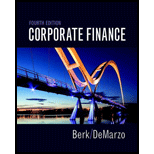
To determine: The equity cost of capital of Company P’s stock.
Introduction:
Cost of capital refers to the return that the investors expect on a particular investment. In other words, it refers to the compensation demanded by the investors for using their capital.
Answer to Problem 1P
The equity cost of capital of Company P’s stock is 5.85 percent.
Explanation of Solution
Given information:
Company P’s stock has a beta of 0.57. The risk-free rate is 3 percent and the market portfolios expected return is 8 percent.
The formula to calculate the expected return using CAPM is as follows:
Note: The cost of capital is estimated by computing the expected return. The
Here
“E (Ri)” refers to the expected return on a risky asset.
“Rf” refers to the risk-free rate.
“E (RM)” refers to the expected return on the market portfolio.
“βi” refers to the beta coefficient of the risky asset relative to the market portfolio.
Calculate the expected return or cost of the capital as follows:
Hence, the cost of capital is 5.85%.
Want to see more full solutions like this?
Chapter 12 Solutions
Corporate Finance (4th Edition) (Pearson Series in Finance) - Standalone book
- Suppose Pepsico's stock has a beta of 0.51. If the risk-free rate is 3% and the expected return of the market portfolio is 9%, what is Pepsico's equity cost of capital? (Round to two decimal places)arrow_forwardSuppose you estimate that stock A has a volatility of 32% and a beta of 1.42, whereasstock B has a volatility of 68% and a beta of 0.75.(a) Which stock has more total risk?(b) Which stock has more market risk?(c) Suppose the risk-free rate is 2% and you estimate the market’s expected return as10%. Which firm has a higher cost of equity capitalarrow_forwardLandscapers R Us, Inc., has a beta of 1.6 and is trying to calculate its cost of equity capital. If the risk-free rate of return is 4 percent and the expected return on the market is 10 percent, then what is the firm's cost of equity capital?arrow_forward
- The Graber Corporation's common stock has a beta of 1.6. If the risk-free rate is 5.6% and the expected return on the market is 10%, what is the company's cost of equity capital?arrow_forwardThe risk free rate currently have a return of 2.5% and the market risk premium is 4.22%. If a firm has a beta of 1.42, what is its cost of equity?arrow_forwardSuppose Pepsico's stock has a beta of 0.76. If the risk-free rate is 3% and the expected return of the market portfolio is 8%, what is Pepsico's equity cost of capital? Pepsico's equity cost of capital is %. (Round to two decimal places.)arrow_forward
- The current beta for The Garner Company is 1.6. The risk-free rate of return is 3%, whereas the market risk premium is 7%. How much would the cost of equity rise if the company extends its operations to the point where its beta reaches 1.9?arrow_forwardWhat is required return using the capital asset pricing model if a stock's beta is 1.2 and the individual, who expects the market to rise by 11.2%, can earn 4.4% invested in a risk-free Treasury Bill?arrow_forwardYour estimate of the market risk premium is 6%. The risk-free rate of return is 4% and General Motors has a beta of 1.4. What is General Motors' cost of equity capital? A. 13.0% B. 12.4% C. 11.8% D. 11.2%arrow_forward
- Diddy corp. has a beta of 1.3. The current risk-free rate is 3 percent and the expected return on the market is 12.50 percent. What is diddy's cost of equity?arrow_forwardSuppose Pepsico's stock has a beta of 0.75. If the risk-free rate is 4% and the expected return of the market portfolio is 6%, what is Pepsico's equity cost of capital? Pepsico's equity cost of capital is enter your response here%. (Round to two decimal places.)arrow_forwardThe firm's beta is 1.2. The risk-free rate is 4.0% and the expected market return is 9%. What is the cost of equity using CAPM?arrow_forward
 Intermediate Financial Management (MindTap Course...FinanceISBN:9781337395083Author:Eugene F. Brigham, Phillip R. DavesPublisher:Cengage Learning
Intermediate Financial Management (MindTap Course...FinanceISBN:9781337395083Author:Eugene F. Brigham, Phillip R. DavesPublisher:Cengage Learning
